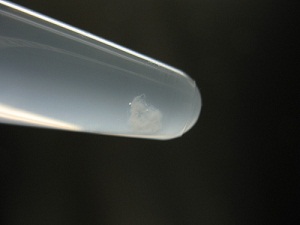Question:
How Genomic DNA extraction works?
The Protein Man Says:
 While there may be a number of ways by which you can successfully isolate your genomic DNA from your sample, your final choice of which genomic DNA extraction protocol to use will ultimately depend on several factors which includes the following:
While there may be a number of ways by which you can successfully isolate your genomic DNA from your sample, your final choice of which genomic DNA extraction protocol to use will ultimately depend on several factors which includes the following:
- the molecular weight of the DNA of interest;
- quantity and purity required to facilitate downstream applications;
- ease or complexity of your chosen method;
- time requirements; and
- budgetary constraints.
Basic Genomic DNA Extraction Procedure
Genomic DNA can be separated from all other cellular components by simply following these three basic steps:
- Disruption and cell lysis. In extracting your genomic DNA from the sample, you need to break down the cell walls that protect the DNA by using enzymes such as lysozyme and proteinase K or by using physical methods such as manual grinding (mortar and pestle method), freeze-thaw technique, sonication, liquid homogenization and/or mechanical disruption with the use of a Waring blender or a polytron. You can also use bead beating (using 0.1 mm glass beads or 0.15 mm garnet beads) to release your genomic DNA from your cell lysate.
- Removal of proteins and other contaminants. After successfully lysing the sample, you should remove the membrane lipids by using appropriate detergents or surfactants. Cellular and histone proteins, on the other hand, can be removed by using suitable proteases or by precipitating them with sodium or ammonium acetate. They can also be removed by extracting them with phenol-chloroform mixture before precipitating the DNA from the solution. A chelating agent can likewise be added to the mixture to prevent DNase from degrading the DNA of interest.
- DNA recovery. After completing these steps, you can now isolate DNA of interest by precipitating it with ice cold ethanol or isopropanol, phenol-chloroform extraction, or mini-column precipitation. The resulting DNA pellets are then washed with alcohol, dried and eventually re-suspended in an appropriate buffer such as Tris or TE ready for use in downstream applications.
Now that you understand the basic genomic DNA extraction protocol, we will be discussing some of the most common protocols used in isolating DNA from your cell lysate in our next post so watch out for it.
Image By - gskx






